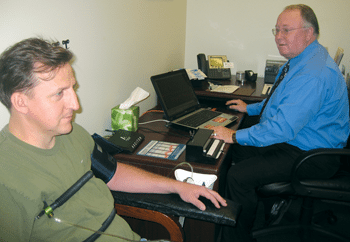Though the reliability of brain scanning for lie detection is still under question, these tests are fast becoming popular with the crime investigating teams. Here’s how they work
DR S.S. VERMA

Police use lie detectors to crack criminal cases. Based on the signals caught from the criminals, they can decide to proceed the investigation further or not.
Various scientific tools of interrogation are in use, like the psychological tests, narco tests and polygraphic tests. But, their reliability in courtrooms is still an issue. These tests generally don’t have legal validity in court and they can only assist police investigations. At the same time, these lie detection tests prove to be a futile exercise in the case of mastermind criminals.
New technologies are being developed so as to replace the traditional lie detection methods. Here we discuss some of the prevailing and upcoming methods of lie detection.
Psychological test
Psychological tests are usually administered and interpreted by a psychologist. These tests assess and evaluate the information that is given by the criminal to the examiner. The information is taken either in the form of answers to interview questions or as answers on paper—or on a computer—to specific questions.
Ultimately, the accuracy of a physiological test depends on how carefully and seriously the answers are given. Hence, no psychological test is ever completely valid or reliable because the human psyche is just too complicated to know anything about it with full confidence. That’s why there can be uncertainty about a case even after extensive testing.
Narco test
The term ‘narco-analysis’ is derived from the Greek word ‘nark’ (meaning ‘anesthesia’ or ‘torpor’). It is a diagnostic and psychotherapeutic technique that uses psychotropic drugs, particularly barbiturates, to induce a stupor in which mental elements with strong associated affects come to the surface, where they can be exploited by the therapist.
The narco analysis test lowers a subject’s inhibitions by interfering with his nervous system at the molecular level, in the hope that the subject will more freely share information and feelings. In this state, it becomes difficult though not impossible for him to lie. The subject is not in a position to speak up on his own but can answer specific but simple questions.
The answers are believed to be spontaneous as a semi-conscious person is unable to manipulate the answers. However, crime branch
officials have found that key suspects took anaesthetic drugs (like Catamine, Propofol, Pentothal and Fortwin) to cheat narco tests, in case they were arrested. Regular use of the drugs made them immune to narco tests. This effectively puts a question mark on all ‘revelations’ made during narco tests so far.
Polygraph test
Polygraph examination is based on the assumption that there is an interaction between the mind and body. It is conducted by various components or the sensors of a polygraph machine, which are attached to the body of the person who is interrogated by the expert.
Polygraph machines are essentially biofeedback devices. The machine records the blood pressure, pulse rate, respiration, muscle movements and electrical resistance of the skin. Polygraph test is conducted in three phases: a pretest interview, chart recording and diagnosis.
Even with a trained and skillful administrator, polygraph technology is not altogether perfect at detecting lies. There is a lot of variability in how different people react when lying first of all. The act of being measured tends to produce anxiety, which creates the possibility of false positives. The worst part is that there are people out there who are so good at lying that they believe their own lies (or at least are in large part non-reactive) and thus don’t perturb the polygraph.
Brain mapping
In the brain mapping method (P300), also called ‘brain-wave fingerprinting,’ the accused is first interviewed and interrogated to find out whether he is concealing any information. Then sensors are attached to his head and he is made to sit before a computer monitor. The accused is then shown certain images or made to hear certain sounds. The sensors monitor electrical activity in his brain and register P300 waves, which are generated only if the subject has connection with the stimulus, i.e., picture or sound. The subject is not asked any question here.
Functional magnetic resonance imaging
In functional magnetic resonance imaging (fMRI) experiments, the subject usually alternates between performing a mental task and resting (or undertaking an alternative task) while repeated images of his brain are rapidly captured. Areas of the brain in which there are strong correlations between the performance of the task and the MRI signal time course are then identified as having been involved in that task.
When the subject starts to perform the task, neuronal activity increases in the required parts of the brain. These areas require additional energy, which is provided by an increase in the regional blood supply. This increase in blood flow leads to an increase in the blood oxygenation level, which, in turn, changes the magnetic properties of the blood and hence the MRI signal.






